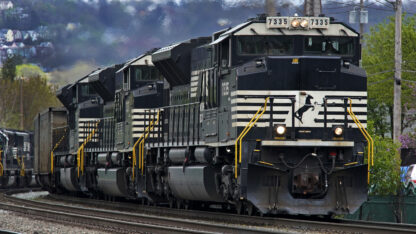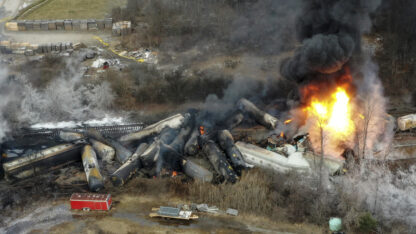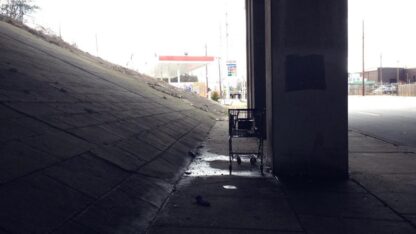Residents of eastern Ohio can now get an up-close view in newly released videos of the twin toxic towers of fire that forced them from their homes last February after officials decided to blow open five tank cars filled with vinyl chloride they worried might explode days after the Atlanta-based Norfolk Southern train derailed.
The National Transportation Safety Board released more than a half-dozen videos of the explosions, fire and huge plume of black smoke generated along with documents unearthed in their investigation about what went into the decision to release and burn the vinyl chloride.
Those documents reinforce the questions raised last spring at the hearings the NTSB held in East Palestine, Ohio, about whether the tank cars really would have exploded while they were surrounded by the fire from the derailment. The officials who made that decision have defended it, saying they made the best call they could with the information they had available that day.
The company that made the chemical, Oxy Vinyls, told investigators they believed the vinyl chloride remained stable and wouldn’t explode, but it was revealed last year that the opinion of Oxy Vinyls’ experts wasn’t shared with key decision-makers. Instead, they decided to blow open the cars because of the concerns about the cars’ temperature readings and whether pressure relief valves were working.
Residents are still worrying about the potential health consequences of that decision and the derailment itself as the one-year anniversary of the derailment near the Ohio-Pennsylvania border approaches on Saturday. Key health questions remain unanswered although many who live in East Palestine just want to move forward with rebuilding their town.
State and federal Environmental Protection Agency officials have said their tests haven’t shown toxic levels of chemicals since the evacuation order was lifted. The massive cleanup that included removing more than 176,000 tons of contaminated soil from around the derailment continues but could wrap up around the middle of this year.
There are also details in the documents about the trackside detectors that spotted a bearing heating up on one of the rail cars but didn’t trigger an alarm early enough for the crew to stop the train before the derailment. The NTSB blamed that overheating bearing for causing the derailment in the preliminary report, but their full investigation likely won’t be complete until this summer.
In the 30 miles (48 kilometers) before East Palestine, the eastbound train passed three detectors designed to spot hot wheel bearings that showed the temperature of a bearing on one of the cars steadily increasing.
A Norfolk Southern assistant vice president for signals told the NTSB the first two detectors “did not trigger any alarms or alerts” that would have required action by the crew or the sole employee monitoring them across the railroad from Georgia.
But the official later said that as the train passed through Salem, Ohio, which is about 26 miles (42 kilometers) from East Palestine, a sensor sent a non-critical alert to an analyst about the bearing heating up. Video gathered by NTSB investigators showed sparks or fire beneath one of the rail cars starting in Salem.
The analyst was working through other alerts in his queue and “did not get to that alert immediately,” said the Norfolk Southern official, whose name was redacted in these latest documents.
Railroad procedures called for monitoring of the wheel until the next detector. “It would not have been an event that we would have expected immediate action to be taken at that point in time,” the official said.
As the ill-fated train passed a sensor in East Palestine, the bearing surged to 253 degrees above the ambient temperature and sent a “critical alarm” to the crew to stop the train and check the axle.
NTSB has said the crew acted properly and tried to stop the train, but it derailed before coming to a complete stop.
An East Palestine Police Department report said that six days before the derailment, authorities got a call from a woman reporting that a different train was on fire.
An East Palestine police officer reported seeing a six-car train with three of the cars dragging wheels like the brakes were on, causing sparks to fly about 30 feet from the train. Two of the cars had flames under them, the officer wrote.
“As the train continued on through the North Market crossing, the engineer gave me a thumbs up and a smile, like this was everyday stuff,” the officer wrote. “Had dispatch call and advise Norfolk, but the train continued into Pennsylvania.”
In response, Norfolk Southern told authorities the train was out of East Palestine’s area, that they should cancel responding firefighters, and the railroad would call back if they were needed, the report said. It wasn’t clear what happened to that train and whether it was stopped to remove the car that was on fire after the train left town.










